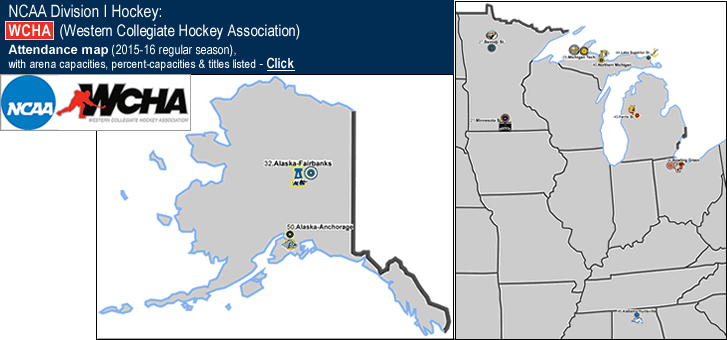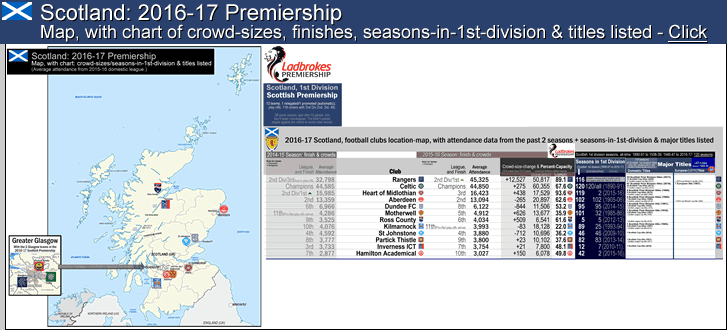
NCAA Division I Hockey: Hockey East conference: attendance map (2015-16 regular season), with arena capacities, percent-capacities & NCAA D1-hockey titles listed
…
…
By Bill Turianski on 30 December 2016; twitter.com/billsportsmaps.
Links…
-Conferences…Division I in ice hockey.
-Teams in Hockey East, etc…Hockey East (en.wikipedia.org).
-My recent post of D1-hockey (map with all 60 teams & 2015-16 attendance.
Conference-maps for NCAA Division I (aka D1) men’s ice hockey
(Note: already-posted D1-hockey conference maps are linked-to, below.)
I have made a location-map for each of the 6 D1-hockey conferences, which are…
∙Atlantic Hockey Association (11 teams/est. 1998-99/ zero titles).
∙Big Ten Conference hockey (6 teams [7-teams in 2017-18]/est. 2013-14/ 23 titles won amongst its six teams).
∙ECAC Hockey (12 teams/est. 1961-62/ 7 titles won amongst its twelve teams).
∙Hockey East Association (12 teams [11 teams in 2017-18]/est. 1984-85/ 13 titles won amongst its twelve teams).
∙National Collegiate Hockey Conference (aka NCHC) (8 teams/est. 2013-14/ 18 titles won amongst its eight teams).
∙Western Collegiate Hockey Association (aka WCHA) (10 teams/est. 1951-52/ 8 titles won amongst its ten teams).
…
The location-map here shows the 12-team Hockey East conference.
The Hockey East conference has teams spread throughout the 6 New England states, plus Notre Dame in Indiana – but Notre Dame will be leaving the Hockey East conference after the 2016-17 season, to join Big Ten Conference hockey {for that, see my post on Big Ten conference hockey}.
Once Notre Dame leaves (after 2016-17), Hockey East will once again be based entirely in the New England states…
Hockey East has 6 teams from Massachusetts. One is based in the central region of the state: UMass (of Amherst, MA/which is 75 miles west of Boston). 5 teams are based in the College-hockey-Mecca of Greater Boston…with Boston University and Northeastern in Boston, proper; and 3 teams in Greater Boston…Boston College (of Chestnut Hill, MA/6 miles west of downtown Boston), UMass-Lowell (of Lowell, MA/23 miles north), and Merrimack College [of North Andover/33 miles north of the Hub]). One team is located in Vermont (Vermont [of Burlington, VT, which is on the eastern side of Lake Champlain]). One team is located in New Hampshire (UNH or New Hampshire [of Durham, NH, which is just east of Manchester, NH and is a few miles inland from Portsmouth, NH, and is 54 miles north of Boston]). One team is located in Maine (Maine [of Orono, ME, which is 115 miles north-east and inland from Portland, ME]). One team is located in Rhode Island (Providence [of Providence, RI, which is 41 miles south of Boston]). And one team is located in Connecticut (UConn – aka Connecticut [of Storrs, CT, with the team playing home games 26 miles west in Hartford, CT]).
The map…
The map is based on my recently-posted 60-team NCAA D1-hockey location-map {see it here}. The 12 Hockey East teams’ crests, colors and locations are shown on the map. Each team’s color-circle, which radiates out from their location-dot, is sized to represent average attendance…the larger the circle, the higher the team’s average attendance. Crowd-size-rank within the 60-team-D1 is also noted – by the number next to the team-name on the map and on the attendance-list. (North Dakota is the highest-drawing D1-hockey team, currently.)
The chart at the right side of the map page shows attendance data. Along with average attendances of the Hockey East teams (2015-16 home regular season figures), arena sizes and percent-capacities are listed. Also shown, below the attendance data, is a list showing all D1-hockey titles which have been won by teams that currently play in the conference (in this case, all titles won by teams in Hockey East). Finally, at the lower-right of the map-page is a chart showing all D1-hockey teams’ titles and Frozen Four appearances (39 of the 60 D1-hockey teams).
Hockey East was established in 1984-85…
Hockey East was formed in 1984-85, by five former ECAC teams: the Boston College Eagles, the Boston University Terriers, the New Hampshire Wildcats, the Northeastern Huskies, and the Providence Friars. These 5 decided to create their own league, because of scheduling concerns (they feared that the Ivy League teams in the ECAC would form their own conference, but that never came about). It also cannot be denied that the Hockey East set-up has decreased travel costs among its member-teams (seeing as it is basically a New-England-only-based conference). Before Hockey East’s inaugural season started in the fall of 1984, two more teams joined the new conference: the Maine Black Bears and the UMass-Lowell River Hawks. The Merrimack Warriors joined Hockey East in 1989-90. The UMass Minutemen joined Hockey East in 1994-95. The Vermont Catamounts joined Hockey East in 2005-06. And the UConn Huskies joined in 2014-15.
Of the top 20-drawing D1-hockey teams, 7 are from Hockey East.
#8-best-drawing UMass-Lowell River Hawks draw in the mid-5-K-range (5,592 per game and at a solid 93.2 percent-capacity in their 6-K-capacity arena). UConn draws 5.1K, Boston College draws 4.9 K, New Hampshire draws 4.8 K, Boston University draws 4.3 K, and Maine (the 20th-highest drawing D1-hockey team), draws 3.9 K. (Note: soon-to-be-departed-for-the-Big-Ten Notre Dame also draws in the top 20, at 4.9 K in their 5.0-K-capacity arena, for a very good 94.6 percent-capacity.) One other note: Providence and Vermont both play to some of the best percent-capacities in D1-hockey…2015 champs Providence basically play to sold-out crowds these days, drawing 2.9 K in their 3.0-K-capacity arena at 98.3 percent-capacity; while Vermont is 21st-highest-drawing D1-hockey team at 3.8 K in their 4.0-K-capacity arena, for an outstanding 95.7 percent-capacity.
In the 32 seasons since Hockey East was formed, there have been 9 D1-hockey titles won by Hockey East teams.
Those 9 titles have been won by 4 teams…the Boston College Eagles, with 4 [of their 5] D1 titles won as a Hockey East team (in 2001, 2008, 2012, and 2014); the Maine Black Bears, with both of their D1 titles won as a Hockey East team (in 1993 and 1999), the Boston University Terriers, with 2 [of their 5] D1 titles won as a Hockey East team (in 1995 and 2009); and the Providence Friars, who won their first D1-hockey title two seasons ago in 2015. So, that means Hockey East has won 28 percent of the last 32 D1-hockey titles, since its inception. That shows you that Hockey East is one of the elite D1-hockey conferences.
Hockey East has also produced 14 other D1-championship-game-finalists. As far as Final Four appearances go, 9 of the 12 Hockey East teams have made it to the Final Four at least once, with Boston College having made the most Final Four appearances of all the D1-hockey teams: 25 times, including last year (2016). Boston University also has a large number of Final Four appearances: 22 (last in 2015). To round out the rest…Maine has made 11 Final Four appearances (last in 2007). New Hampshire has made 7 Final Four appearances (last in 2003). Providence has made 4 Final Four appearances (last in 2015). Vermont has made 2 Final Four appearances (last in 2009). U-Mass Lowell made a Final Four appearance in 2014. And Northeastern made a Final Four appearance in 1982. (Notre Dame has made 2 Frozen Four appearances (last in 2011).)
___
Thanks to all at the following links…
-Thanks to AMK1211 for blank map of USA, ‘File:Blank US Map with borders.svg”>File:Blank US Map with borders.svg‘ (commons.wikimedia.org).
-Thanks to Two Hearted River at en.wikipedia.org/[each teams' page at Wikipedia], for small segments of jersey illustrations of several teams (Wisconsin, Minnesota-Duluth, Cornell, Maine, Minnesota State, Vermont, Yale, UMass, Western Michigan, Canisius College, American International), such as at File:ECAC-Uniform-Cornell.png.
-Thanks to USCHO site for attendance data, Men’s Division I Hockey Attendance: 2015-2016 (uscho.com).






